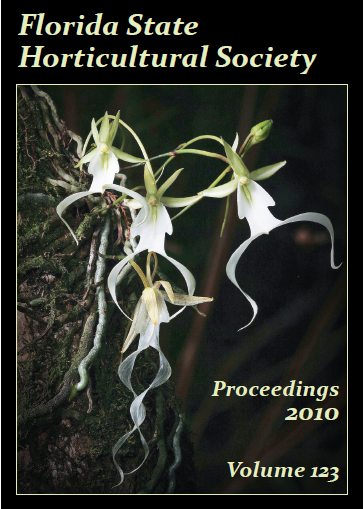Citrus
Abstract
Leaf wetness duration (LWD) is a key parameter in some disease warning systems and as an input to biological modeling of infection of many plant diseases in crops. The main objective of this study was to determine the spatial heterogeneity of LWD within citrus canopies during summer and winter conditions. The spatial variability of LWD was evaluated in citrus trees in central Florida at 12 canopy positions during Aug. 2008 and Feb. 2009. The analysis of LWD measurements revealed statistical heterogeneity among sensor heights and horizontal positions. LWD was significantly higher (P < 0.0001) at the top canopy compared to the middle and bottom positions during rainy days and no-rain days. The differences in mean daily LWD between top and bottom canopy during a 31-d period of time in the summer were 2.9 and 2.5 h during no-rain and rain days, respectively. The difference in mean daily LWD during a 30-d period in the winter with no-rain days was 2.6 h. The comparison by linear regression analysis between sensors within the canopy and a sensor installed at 30 cm (0.98 ft) over turf grass in a nearby Florida Automated Weather Network (FAWN) station showed that the station sensor provides accurate estimates of LWD at the top of the canopy. These findings accentuate the importance of accounting for the impact of spatial heterogeneity when LWD is used as input to disease-warning systems.References
- Agrios, G.N. 2005. Plant pathology. Fifth edition. Elsevier-Academic Press, San Diego, CA.
- Batzer, J.C., M.L. Gleason, S.E. Taylor, K.J. Koehler, and J.E.B.A. Monteiro. 2008. Spatial heterogeneity of leaf wetness duration in apple trees and its influence on performance of a warning system for sooty blotch and flyspeck. Plant Dis. 92:164–170.
- Beysens, D. 1994. The formation of dew. Atmos. Res. 39:215–237.
- Bhatia A., P.D. Roberts, and L.W. Timmer. 2003. Evaluation of the Alter-Rater model for timing of fungicide applications for control of Alternaria brown spot of citrus. Plant Dis. 87:1089–1093.
- Gillespie, T.J and P.C. Sentelhas. 2008. Agrometeorology and plant disease management—A happy marriage. Sci. Agr. 65:71–75.
- Gleason, M.L., K.B. Duttweiler, J.C. Batzer, S. Elwynn, P.C. Sentelhas. J.E.B.A. Monteiro, and T.J. Gillespie. 2008. Obtaining weather data for input to crop disease-warning systems: Leaf wetness duration as a case study. Sci. Agr. 65:76–87.
- Huber, L. and T.J. Gillespie. 1992. Modeling leaf wetness in relation to plant disease epidemiology. Annu. Rev. Phytopathol. 30:553–577.
- Jacobs, A.F.G., W.A.J. Van Pul, and A. Van Dijken. 1990. Similarity of moisture dew profiles within a corn canopy. J. Appl. Meteorol. 29:1300–1306.
- Klemm, O., C. Milford, M.A. Sutton, G. Spindler, and E. Van Putten. 2002. A climatology of leaf surface wetness. Theor. Appl. Climatol. 71:107–117.
- Magarey, R.D. 1999. A theoretical standard for estimation of surface wetness duration in grape. PhD Diss., Cornell University, Ithaca, NY.
- Penrose, L.J. and H.I. Nicol. 1996. Aspects of microclimate variation within apple tree canopies and beween sites in relation to potential Venturia inequalis infection. N.Z. J. Crop Hort. 24:259–266.
- Peres, N.A.R., N.L. Souza, E.L. Furtado, and L.W. Timmer. 2004. Evaluation of systems for timing of fungicide sprays for control of postbloom fruit drop of citrus in Brazil. Plant Dis. 88:731–735.
- Santos, E.A., P.C. Sentelhas, J.E. Macedo, L.R. Angelocci, and J.E. Boffino. 2008. Spatial variability of leaf wetness duration in cotton, coffee and banana crop canopies. Sci. Agr. 65:18–25.
- Sentelhas, P.C., T.J. Gillespie, M.L. Gleason, J.E.B.A. Monteiro, and S.T. Helland. 2004. Operational exposure of leaf wetness sensors. Agr. For. Meteorol. 126:59–72.
- Sentelhas, P.C., T.J. Gillespie, J.C. Batzer, M.L. Gleason, J.E.B.A. Monteiro, J.R.M. Pezzopane, and M.J. Pedro, Jr. 2005. Spatial variability of leaf wetness duration in different crop canopies. Intl. J. Biometeorol. 49:363–370.
- Sentelhas, P.C., T.J. Gillespie, M.L. Gleason, J.E.B. . Monteiro, J.R. Pezzopane, and M.J. Pedro, Jr. 2006. Evaluation of a Penman-Monteith approach to provide “reference” and crop canopy leaf wetness duration estimates. Agr. For. Meteorol. 141:105–117.
- Spann, T.M., R.A. Atwood, J.D. Yates, R.H. Briansky, and K.R. Chung. 2008. Dooryard citrus production: Citrus diseases exotic to Florida. Publ. No. HS1132, University of Florida, IFAS, EDIS, Gainesville.
- Timmer, L.W. and S.E. Zitko. 1996. Evaluation of a model for prediction of postbloom fruit drop of citrus. Plant Dis. 80:380–383.
- Timmer, L.W., H.M. Darhower, and A. Bhatia. 2001. The Alter-Rater, a new weather-based model for timing fungicide sprays for Alternaria control. Publ. No. PP-175, University of Florida, IFAS, EDIS, Gainesville.
- Zhang, Y. and T.J. Gillespie. 1990. Estimating maximum droplet wetness duration on crops from nearby weather station data. Agr. For. Meteorol. 51:145–158.

